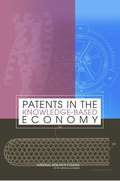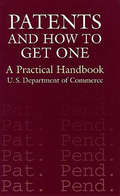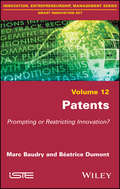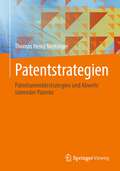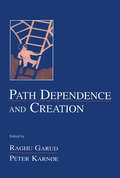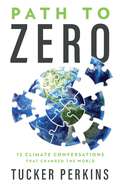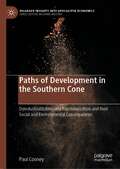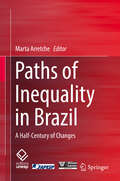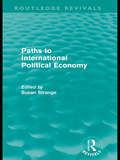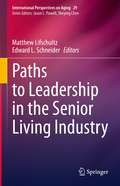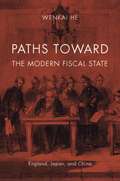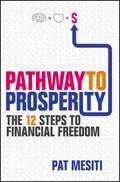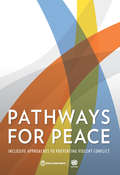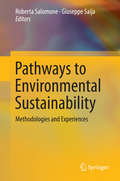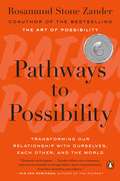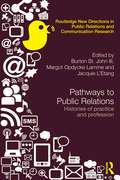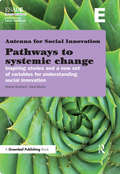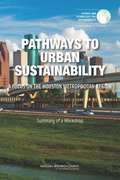- Table View
- List View
Patents In The Knowledge-based Economy
by Committee on Intellectual Property Rights in the Knowledge-Based EconomyThis volume assembles papers commissioned by the National Research Council’s Board on Science, Technology, and Economic Policy (STEP) to inform judgments about the significant institutional and policy changes in the patent system made over the past two decades. The chapters fall into three areas. The first four chapters consider the determinants and effects of changes in patent “quality. ” Quality refers to whether patents issued by the U. S. Patent and Trademark Office (USPTO) meet the statutory standards of patentability, including novelty, nonobviousness, and utility. The fifth and sixth chapters consider the growth in patent litigation, which may itself be a function of changes in the quality of contested patents. The final three chapters explore controversies associated with the extension of patents into new domains of technology, including biomedicine, software, and business methods.
Patents and How to Get One: A Practical Handbook
by U.S. Department of CommerceWhat is a patent? What do “patent pending” and “patent applied for” mean? How do you go about applying for a patent? This indispensable handbook, originally published by the U.S. Government’s Patent and Trademark Office (PTO) not only answers these and many other questions frequently asked of the agency, but provides readers with general information about patents and how the PTO operates.Designed specifically for non-attorneys and written in clear, easy-to-understand language, the guide takes readers through the registration process step by step, beginning with general information about the functions of the Patent and Trademark Office. Accessible discussions follow about patent law, what can be patented, conditions for obtaining a patent, the process of registering patents, and who may apply. Also covered are filing and maintenance fees; models, exhibits, and specimens; correction of patents, the nature of patent rights, patent infringement, design and plant patents, treaties and foreign patents, and much more.Of immense use to inventors and prospective applicants, this brief general introduction to the subject will also be of value to students and other interested people.
Patents: Prompting or Restricting Innovation?
by Marc Baudry Béatrice DumontThe patent system is criticized today by some practitioners and economists. In fact, there is a partial disconnection between patent demographics and productivity gains, but also the development of actors who do not innovate and who develop business models that their detractors equate with a capture of annuities or a dangerous commodification of patents. This book provides a less Manichaean view of the position of patents in the system of contemporary innovation. It first recalls that these criticisms are not new, before arguing that if these criticisms have been revived, it is because of a partial shift from an integrated innovation system to a much more fragmented and open system. This shift accompanied the promotion of a more competitive economy. The authors show that this movement is coherent with a more intensive use of patents, but also one that is more focused on their signal function than on their function of direct monetary incentive to innovation.
Patentstrategien: Patentanmeldestrategien und Abwehr störender Patente
by Thomas Heinz MeitingerPatentstrategien können in Patentanmeldestrategien und Strategien zur Abwehr störender Patente unterteilt werden. In aller Regel werden Patente und nicht Patentanmeldungen als störend empfunden, da Patentanmeldungen im Gegensatz zu Patenten nicht durchgesetzt werden können bzw. da es noch überhaupt nicht bekannt ist, was überhaupt der Schutzbereich eines durchsetzungsfähigen Patents aus der Anmeldung sein wird. Der Schutzumfang wird erst durch die Patenterteilung bestimmt. Dann ist es möglich, dass der Schutzumfang der erteilten Anmeldung nicht mehr stört, da das eigene Produkt keine Patentverletzung darstellt. Außerdem ist es möglich, dass sich aus einer Patentanmeldung überhaupt kein Schutzbereich ergibt, da die Patentanmeldung zurückgewiesen wird. Eine Patentanmeldung ist eben ein noch ungeprüftes Schutzrecht. Ein eingetragenes Gebrauchsmuster ist ebenfalls ein ungeprüftes Schutzrecht, obwohl es als vollständig durchsetzbares Schutzrecht gilt. Dennoch wird es der Inhaber eines eingetragenen Gebrauchsmusters schwer haben, eine einstweilige Verfügung ohne vorherige mündliche Anhörung der Gegenseite zu erhalten. Die Chancen hierfür sind bei einem Patent deutlich besser.Der Anmelder einer Patentanmeldung wird sich spätestens kurz vor Ablauf des Prioritätsjahrs vor die Frage gestellt sehen, ob er Nachanmeldungen in ausländischen Ländern vornehmen soll. Hierbei ist es relevant, in welchen Ländern wichtige Märkte für ihn sind und in welchen Ländern die Wettbewerber ihre Produktionsanlagen haben. Außerdem benötigt der Anmelder Informationen, wie am effektivsten und am kostengünstigsten Nachanmeldungen vorzunehmen sind bzw. welche Patentanmeldestrategien angewandt werden können. Dieses Fachbuch gibt dem Leser die Informationen an die Hand, die geeignete Anmeldestrategie zu finden und störende Patente abzuwehren.
Path Dependence and Creation (Organization and Management Series)
by Raghu Garud Peter KarnøeThe editors, aware of the recent work in evolutionary theory and the science of chaos and complexity, challenge the sometimes deterministic flavor of this subject. They are interested in uncovering the place of agency in these theories that take history so seriously. In the end, they are as interested in path creation and destruction as they are in path dependence. This book is compiled of both theoretical and empirical writings. It shows relatively well-known industries, such as the automobile, biotechnology, and semi-conductor industries in a new light. It also invites the reader to learn more about medical practices, wind power, lasers, and synthesizers. Primarily written for academicians, researchers, and Ph.D. students in fields related to technology management, this book is research-oriented and will appeal to all managers.
Path to Open Innovation
by Henry ChesbroughThere are significant barriers and costs that an open business model is likely to encounter in most organizations. This chapter discusses the path that companies must walk to open up their innovation processes, using examples of companies that have faced these challenges and strengthened their businesses on the way to open innovation.
Path to Zero: 12 Climate Conversations That Changed the World
by Tucker PerkinsTucker Perkins' Path to Zero shows how we can reverse climate change and create a cleaner environment for future generations by putting aside our biases and working together for change. Climate catastrophe-inspired narratives like &“Electrify Everything!&” have a grip on people&’s minds. The simplicity of the solution to the most complex endeavor ever faced by humans—the journey to a net zero future—is seductive, but it is fundamentally flawed. In Path to Zero: 12 Climate Conversations That Changed the World, author, Tucker Perkins takes readers on a series of future-casting journeys from the Year 2050 back to the present day to show us how a better way—a wide path to net zero carbon emissions—was, and can be, achieved in an accelerated time frame. In this work, Perkins uncovers an array of practical, often obvious, measures the world can take to achieve a better, cleaner future inclusive of energy and power. Unlike other authors and voices of this age, Perkins shows us that change is possible, innovation is happening, and dogmatic devotion to singular solutions is one of the biggest impediments to progress.
Pathology of the Capitalist Spirit: An Essay on Greed, Hope, and Loss
by David LevinePathology of the Capitalist Spirit is about capital and about the economic system that bears its name.
Paths of Development in the Southern Cone: Deindustrialization and Reprimarization and their Social and Environmental Consequences (Palgrave Insights into Apocalypse Economics)
by Paul CooneyThis book analyzes the recent development paths pursued by progressivegovernments in Argentina and Brazil, namely deindustrialization andreprimarization, and the social and environmental consequences thereof. A keypart of understanding the trajectories in both Argentina and Brazil has been therole played by international institutions, especially the IMF and WTO, and also,the ever-growing hegemony of transnational corporations in the global economyand as a result, significantly limiting the possibilities of genuine development forlocal populations. Two major issues which extend beyond Latin America are: the expansion ofgenetically modified crops and agrotoxics and the concern for global food securityand sovereignty; second, how reprimarization, associated with mining, cattle, soyand petroleum, has been key in leading to the risk of desertification in theArgentine pampas and also causing deforestation in the Amazon Rain forest,described as the lungs of the planet, and thus has major implications for climatechange for the planet as a whole. In addition, this book engages with a number of theoretical issues: developmentand dependency in the periphery: neoliberal globalization, accumulation bydispossession, ecological and environmental debates and the role of extractivismand rent. This book is aimed for both academics, activists and those politicallymotivated to analyze, understand and push for social change from a criticalperspective, and also, those interested in a radical analysis of paths ofdevelopment, dependency and socioenvironmental issues in Latin America today.
Paths of Enterprise: The Future of Small Business (Social Analysis)
by James Curran Robert A. BlackburnWhile small scale enterprise has expanded rapidly in recent years the way ahead looks uncertain. Drawing together recent research and thinking on small business activities from several disciplines, this book gives a comprehensive picture of the current situation and assesses the future. It evaluates the impact of such diverse influences as technological innovation, demogrpahic change, changes in orgh environment, women and entreprenuership, and by analysing trends in employment levels, banking policies and government schemes it explores ways to survive in an increasingly hostile environment.
Paths of Inequality in Brazil: A Half-Century of Changes
by Marta ArretcheThis book presents multidisciplinary analyses of the historical trajectories of social and economic inequalities in Brazil over the last 50 years. As one of the most unequal countries in the world, Brazil has always been an important case study for scholars interested in inequality research, but in the last few decades has brought a new phenomenon to renew researchers’ interest in the country. While the majority of democracies in the developed world have witnessed an increase in income inequality from the 1970s on, Brazil has followed the opposite path, registering a significant reduction of income inequality over the last 30 years. Bringing together studies carried out by experts from different areas, such as economists, sociologists, demographers and political scientists, this volume presents insights based on rigorous analyses of statistical data in an effort to explain the long term changes in social and economic inequalities in Brazil. The book adopts a multidisciplinary approach, analyzing the relations between income inequality and different dimensions of social life, such as education, health, political participation, public policies, demographics and labor market. All of this makes Paths of Inequality in Brazil – A Half-Century of Change a very valuable resource for social scientists interested in inequality research in general, and especially for sociologists, political scientists and economists interested in the social and economic changes that Brazil went through over the last two decades.
Paths to International Political Economy (Routledge Revivals)
by Susan StrangeThe problems of a troubled world economy and the essentially political issues of how it should be managed make up the stuff of international political economy. The overwhelming importance of these questions has drawn ever increasing numbers of students and teachers in universities, colleges and schools to study the subject. There are many paths into international political economy for them to follow and this volume, originally published in 1984, discusses most of them. The collection as a whole demonstrates that the field should be seen as the exclusive preserve of neither the economists nor the political scientists. On the contrary, there is much to learn from specialists - and practical people in government and business - with a variety of backgrounds. A rich selection is therefore offered, including history, population studies, money, trade, technology and law, from which the reader can pick and choose at will. The contributions point to the landmarks of the subject and provide useful tips on the best books to read and the most interesting ideas to look out for.
Paths to Leadership in the Senior Living Industry (International Perspectives on Aging #29)
by Matthew Lifschultz Edward L. SchneiderThis book assembles many of the great leaders of the senior living and care industry to discuss their paths to and views on leadership. Each chapter provides readers with ideas, information, and inspiration on how to achieve leadership in this dynamic, mission-focused industry. It includes various strategies for success, such as promoting meaning and purpose in corporate culture, making decisions in the absence of perfect information, managing your personal assets of relationships and reputation, and finding competitive advantages through technology, training, and team-building. These leaders also share their experiences responding to COVID-19 and discuss how the pandemic may change the future of leadership in the industry. Whether your path starts in gerontology, nursing, social work, design, real estate, finance, law, operations, or technology, and whether one pursues work in the private, nonprofit, or government sectors, this volume provides a valuable resource for all aspiring and developing leaders in the senior living industry.
Paths to a Green World: The Political Economy of the Global Environment
by Jennifer Clapp Peter DauvergneThis comprehensive and accessible text fills the need for a political economy view of global environmental politics, focusing on the ways key economic processes affect environmental outcomes.
Paths to the Emerging State in Asia and Africa (Emerging-Economy State and International Policy Studies)
by Keijiro Otsuka Kaoru SugiharaThis book addresses the issue of how a country, which was incorporated into the world economy as a periphery, could make a transition to the emerging state, capable of undertaking the task of economic development and industrialization. It offers historical and contemporary case studies of transition, as well as the international background under which such a transition was successfully made (or delayed), by combining the approaches of economic history and development economics. Its aim is to identify relevant historical contexts, that is, the ‘initial conditions’ and internal and external forces which governed the transition. It also aims to understand what current low-income developing countries require for their transition. Three economic driving forces for the transition are identified. They are: (1) labor-intensive industrialization, which offers ample employment opportunities for labor force; (2) international trade, which facilitates efficient international division of labor; and (3) agricultural development, which improves food security by increasing supply of staple foods. The book presents a bold account of each driver for the transition.
Paths toward the Modern Fiscal State
by Wenkai HeThe rise of modern public finance revolutionized political economy. As governments learned to invest tax revenue in the long-term financial resources of the market, they vastly increased their administrative power and gained the ability to use fiscal, monetary, and financial policy to manage their economies. But why did the modern fiscal state emerge in some places and not in others? In approaching this question, Wenkai He compares the paths of three different nations-England, Japan, and China-to discover why some governments developed the tools and institutions of modern public finance, while others, facing similar circumstances, failed to do so. Focusing on three key periods of institutional development-the decades after the English Civil Wars, the Meiji Restoration, and the Taiping Rebellion-He demonstrates how each event precipitated a collapse of the existing institutions of public finance. Facing urgent calls for revenue, each government searched for new ways to make up the shortfall. These experiments took varied forms, from new methods of taxation to new credit arrangements. Yet, while England and Japan learned from their successes and failures how to deploy the tools of modern public finance and equipped themselves to become world powers, China did not. He’s comparative historical analysis isolates the nature of the credit crisis confronting each state as the crucial factor in determining its specific trajectory. This perceptive and persuasive explanation for China’s failure at a critical moment in its history illuminates one of the most important but least understood transformations of the modern world.
Pathway to Prosperity
by Pat MesitiAn inspiring guide to getting off the road to more debt and financial insecurity and on the road to wealth and financial freedom You can take charge of your financial future. You can reduce your debt, increase your net worth and enjoy a life of prosperity. You can stop struggling, doing things the way you've always have, and embark on a new pathway to wealth. So what's stopping you? According to bestselling motivational author and wealth building advisor, Pat Mesiti, it's all about identifying what's wrong with the way you think and feel about money and the path they've put you on. And it's about creating a new, more prosperous path for yourself. Provides you with the tools you need to create your own roadmap to greater wealth and financial security Gives you priceless insights into your wealth-defeating mindset and how to stop repeating the same mistakes and start building wealth by design--not by chanceOffers proven prescriptions for digging your way out of the debt-heavy financial rut you're in so you can start building wealth right awayFeatures numerous inspiring case studies of Mesiti clients and mentees who found financial freedom following his "shift your mind, touch your heart" approach to wealth
Pathways To Success: How to Win Friends & Influence People and How to Stop Worrying & Start Living
by Dale Carnegie Dorothy CarnegieEIGHT THINGS This Book Will Help you Achieve 1. Get out of a mental rut, think new thoughts, acquire new visions, discover new ambitions. 2. Make friends quickly and easily. 3. Increase your popularity. 4. Win people to your way of thinking. 5. Increase your influence, your prestige, your ability to get things done. 6. Handle complaints, avoid arguments, keep your human contacts smooth and pleasant. 7. Become a better speaker, a more entertaining conversationalist. 8. Arouse enthusiasm among your associates. This book takes you on a step-by-step voyage of self-discovery and improvement. It will culminate in your increased success at relationship-building, setting and achieving goals, overcoming stress, and building leadership strengths. Carnegie's famous maxim, "Believe that you will succeed, and you will" is the corner stone of this book. And it informs all the practical principles about human performance and business results he presents so powerfully here. Through remarkably plain yet brilliant examples, Carnegie's time-honored values have motivated generations of people to be a success-and continue to do so. Both books in this volume have been regular best-sellers from the start, selling copies in the multi-millions. Translated into numerous languages, they are read and reread by business and professional people worldwide. In addition, they are an important part of courses offered in over 70 countries by Dale Carnegie Training.
Pathways for Peace: Inclusive Approaches to Preventing Violent Conflict
by United Nations;World BankViolent conflicts today are complex and increasingly protracted, involving more nonstate groups and regional and international actors. It is estimated that by 2030—the horizon set by the international community for achieving the Sustainable Development Goals—more than half of the world’s poor will be living in countries affected by high levels of violence. Information and communication technology, population movements, and climate change are also creating shared risks that must be managed at both national and international levels. Pathways for Peace is a joint United Nations†“World Bank Group study that originates from the conviction that the international community’s attention must urgently be refocused on prevention. A scaled-up system for preventive action would save between US$5 billion and US$70 billion per year, which could be reinvested in reducing poverty and improving the well-being of populations. The study aims to improve the way in which domestic development processes interact with security, diplomacy, mediation, and other efforts to prevent conflicts from becoming violent. It stresses the importance of grievances related to exclusion—from access to power, natural resources, security and justice, for example—that are at the root of many violent conflicts today. Based on a review of cases in which prevention has been successful, the study makes recommendations for countries facing emerging risks of violent conflict as well as for the international community. Development policies and programs must be a core part of preventive efforts; when risks are high or building up, inclusive solutions through dialogue, adapted macroeconomic policies, institutional reform, and redistributive policies are required. Inclusion is key, and preventive action needs to adopt a more people-centered approach that includes mainstreaming citizen engagement. Enhancing the participation of women and youth in decision making is fundamental to sustaining peace, as well as long-term policies to address the aspirations of women and young people.
Pathways from Preferential Trade
by Tony HeronTony Heron examines recent global policy responses to the erosion of non-reciprocal tariff and quota preferences caused trade liberalizing by focusing on a sample of small, middle income countries which have historically enjoyed favourable access to OECD markets.
Pathways to Environmental Sustainability
by Roberta Salomone Giuseppe SaijaThis book brings together, in a single volume, an overview of multiple applications of the concept of environmental sustainability, featuring examples of useful methodologies and tools for pursuing environmental targets, experiences and case studies spanning a variety of sectors, embracing both industry and research projects; and case studies applied to very different territorial contexts. The first section of the book covers methodologies and tools for environmental sustainability, including Industrial Ecology, Urban Metabolism, Life Cycle Assessment, analysis of industrial water footprint and such chemical technologies as Hypercritical Separation Technology (HYST). Part Two provides case studies of environmental sustainability in specific industrial sectors including electronics, pharmaceutical manufacturing, bio-energy, agriculture, food and residential construction retrofitting. Part Three explores experiences of environmental sustainability in territorial contexts on a local, regional or national scale. This section includes chapters on sustainability in the Republic of San Marino, the European "Covenant of Mayors" urban sustainability initiative and efforts to promote sustainability in Italy, Norway and Poland among others. The book concludes with a discussion of Common Agricultural Policy (CAP) in Objective I regions of Italy. Featuring the contributions of academics, managers operating in various productive sectors and consultants, the book aims to promote the growth and spread of scientific research and technological development for environmental sustainability.
Pathways to Possibility: Transforming Our Relationship with Ourselves, Each Other, and the World
by Rosamund Stone Zander"Rosamund Zander is a miracle. Her generous voice will resonate with you, change you and help you create work that matters." --Seth Godin, author of The Icarus Deception"Fresh, compelling, and uplifting." --Booklist The bestselling author of The Art of Possibility returns with a new vision for achieving true human fulfillmentIn this powerful and inspiring book, family systems therapist and executive coach Rosamund Stone Zander invites readers to shed the childhood stories that hold us back, and enter a realm of true maturity and fulfillment, where limitless growth becomes possible. As children, we develop stories about how the world works, most of which get improved upon and amended over time. But some do not, even as we mature in other ways. Opinionated, self-centered and fear-driven, these "child stories" are the source of the behavioral and emotional patterns that hold us back. When we learn to identify and rewrite these stories, we can do remarkable, even magical things. Zander shows us that life is a story we tell ourselves, and that we have the power to change that story. She illuminates how breaking old patterns and telling a new story can transform not just our own lives, but also our relationships with others--whether in a marriage, a classroom, or a business. Finally, she demonstrates how, with this new understanding of ourselves and our place within an interconnected world, we can take powerful action in the collective interest, and gain a sense of deep connection to the universe. This galvanizing book expands our notions of how much we can grow and change, whether we can affect others or the world at large, and how much freedom and joy we can experience. Stimulating and profound, it is the perfect companion to her beloved first book, The Art of Possibility.From the Hardcover edition.
Pathways to Public Relations: Histories of Practice and Profession (Routledge New Directions in Public Relations & Communication Research)
by Burton St. John Margot Opdycke Lamme Jacquie L’EtangOver the centuries, scholars have studied how individuals, institutions and groups have used various rhetorical stances to persuade others to pay attention to, believe in, and adopt a course of action. The emergence of public relations as an identifiable and discrete occupation in the early 20th century led scholars to describe this new iteration of persuasion as a unique, more systematized, and technical form of wielding influence, resulting in an overemphasis on practice, frequently couched within an American historical context. This volume responds to such approaches by expanding the framework for understanding public relations history, investigating broad, conceptual questions concerning the ways in which public relations rose as a practice and a field within different cultures and countries at different times in history. With its unique cultural and contextual emphasis, Pathways to Public Relations shifts the paradigm of public relations history away from traditional methodologies and assumptions, and provides a new and unique entry point into this complicated arena.
Pathways to Systemic Change: Inspiring Stories and a New Set of Variables for Understanding Social Innovation
by David Murillo Heloise BucklandThe world’s social, ecological and economic problems are so complex and diverse that there will never be a “one-size-fits-all” model for social innovation. The very nature of social innovation as a new, better way of solving social problems means that it is not even in the interest of social innovation advocates to create tidy definitions, but rather to create environments that allow for the process of creative destruction with a social purpose to prosper. Inspired by a desire to deepen our understanding of the role of social innovation in addressing today’s most pressing challenges, authors Heloise Buckland and David Murillo explore four inspiring cases and define a new set of variables to help better understand the conditions under which social innovation can be most effective. These variables can be helpful for investors, governments, academic centres, foundations and individual entrepreneurs interested in measuring the potential of any given social innovation to bring about the much-needed systemic change to solve today’s complex challenges. This book builds on a track record of research and education in corporate social responsibility and social entrepreneurship at ESADE Business School’s Institute of Social Innovation. Building on an understanding of the key characteristics and challenges faced by social entrepreneurs, here authors undertake a deeper analysis of social innovation.
Pathways to Urban Sustainability
by Dominic A. BroseThe workshop was convened to explore the region's approach to urban sustainability, with an emphasis on building the evidence base upon which new policies and programs might be developed. Participants examined how the interaction of various systems (natural and human systems; energy, water, and transportation systems) affected the region's social, economic, and environmental conditions. The objectives of the workshop were as follows: - Discuss ways that regional actors are approaching sustainability- specifically, how they are attempting to merge environmental, social, and economic objectives. - Share information about ongoing activities and strategic planning efforts, including lessons learned. - Examine the role that science, technology, and research can play in supporting efforts to make the region more sustainable. - Explore how federal agency efforts, particularly interagency partnerships, can complement or leverage the efforts of other key stakeholders. Pathways to Urban Sustainability: A Focus on the Houston Metropolitan Region: Summary of a Workshop was designed to explore the complex challenges facing sustainability efforts in the Houston metropolitan region and innovative approaches to addressing them, as well as performance measures to gauge success and opportunities to link knowledge with action. In developing the agenda, the planning committee chose topics that were timely and cut across the concerns of individual institutions, reflecting the interests of a variety of stakeholders. Panelists were encouraged to share their perspectives on a given topic; however, each panel was designed to provoke discussion that took advantage of the broad experience of the participants.
